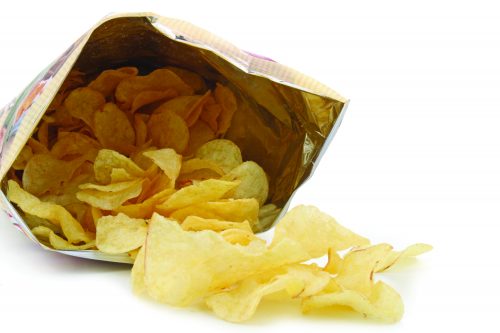
We all know chips aren’t a health food. In fact, the traditional high saturated fat, high salt versions could be described as a heart-stopping combo!
There are, however, healthier options, and we don’t need to compromise on taste by choosing them. Senior nutritionist Rose Carr explains.
Saturated fat
Traditionally potato chips used to be about one-third total fat and 15 per cent (or more) saturated fat. It’s the saturated fat that’s out to kill us: too much can harden our arteries and lead to cardiovascular disease (CVD). Despite better knowledge and some progress over many years, CVD it is still a huge killer in New Zealand and our intakes of saturated fat are still very high.
Chips and crisps are an easy option for entertaining and other ‘treat’ occasions and thankfully there are quite a few products lower in saturated fat than the old-fashioned chip. It’s actually not hard for manufacturers to produce chips with less saturated fat — all they have to do is use a different oil — but of course economics also come into it. We recommend choosing products with 2g or less saturated fat per 100g. If that is too restrictive for you, look for varieties with 5g or less saturated fat per 100g (5 per cent).
In an average 8700kJ day, the recommended upper limit for saturated fat is 22g, so a 50g pack of chips with 5 per cent saturated fat will provide 10 per cent of the daily allowance. For saturated fat, less is definitely better.
Sodium
Higher intakes of sodium (which is largely from salt) are associated with high blood pressure, another risk factor for heart disease. The amount of sodium in chips varies hugely, from around 100mg to more than 1100mg per 100g.
Most of the sodium in our diets comes from processed foods and the sodium level in specific foods is something our taste buds become accustomed to. If we choose lower-sodium products all the time, we become accustomed to a less salty taste in our diet and we don’t miss it. If you cut the amount of sodium in your diet it may take a couple of weeks to get used to it, but it’s worth doing.
We recommend choosing products with 500mg sodium or less per 100g, or if that’s too restrictive aim for 900mg or less per 100g. Again less is definitely better.
Energy
Most chips are energy-dense thanks largely to the amount of fat they contain. We all need fat in our diets but we also know that too much will just add to the waistline.
Traditional chips provide around 2000-2300kJ per 100g (small bags are 40g and the next size up is usually around 150g). Even the better choices are high in energy at around 1600-2000kJ per 100g so a small 40g serve will add 640-800kJ to your day before any ‘extras’. For those watching their weight we normally recommend snacks less than 600kJ. We prefer products with less than 1700kJ or less per 100g, or if that’s too restrictive we recommend choosing varieties with 2000kJ or less per 100g.
Buyer beware!
With chips and crisps, it is really important to look at the nutrition information panel rather than believe the hype: it’s all too easy to misinterpret the words that shout at us on the packaging. Note:
- ‘Light’ or ‘Slim’ does not necessarily mean a product is lower in fat or kilojoules
- ‘Baked not fried’ does not necessarily mean a product is lower in fat or kilojoules
- ‘Less saturated fat’ is compared to a traditional chip high in saturated fat. It may still be higher in saturated fat than alternatives.
We strongly recommend you compare products before you buy. If you only look at two things, compare the saturated fat and the sodium.
www.healthyfood.com










